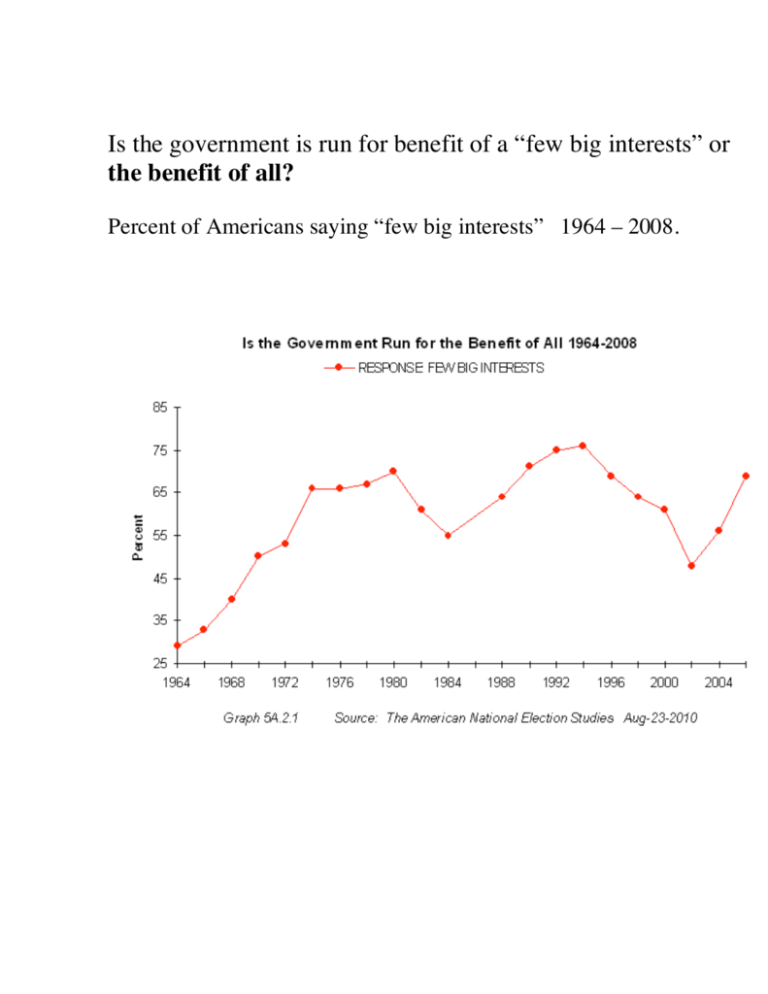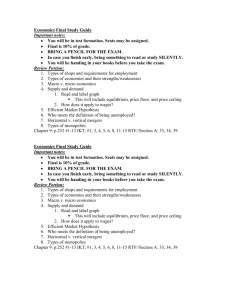Is the government is run for benefit of a “few big interests” or the
advertisement

Is the government is run for benefit of a “few big interests” or the benefit of all? Percent of Americans saying “few big interests” 1964 – 2008. Are officials "crooked"? 1958-2008 How much of the time can you trust the federal government in Washington DC to do what is right? Always, most of the time, or only some of the time? Percent of Americans saying only sometimes or never, 1958 – 2008: Why low trust? Why do people think officials "crooked"? Why do they thing government run for "few big interests?" "Special interests" more power now? Growing gap between rich and poor? Change in media coverage of government? Government policy not what people want? Then who's interests does it reflect? Trends follow economic conditions? Events Watergate Vietnam Reagan administration convictions Clinton impeachment Campaign fundraising scandals Bush White House leaks, indictments etc. I. Interest Groups A. In contemporary perspective: 1. What role for interest groups? • what are “special interests”? 2. Why public cynicism w/ politics? Americans think: government works for "big interests" government can’t be trusted to "do the right thing” 3. Can interest groups replace political parties? • Can interest groups play the same role as parties at making our “Madisonian system” work? • Can interest groups govern in “public” interest? 4. Why are Americans cynical about interest groups? Do we simply misunderstand pluralist competition? Do some interests have inordinate power? • how/why do groups form? • how are they maintained? • what groups do people join? • what groups don’t people join? Campaign finance 5. Other issues: does bias in interest groups system affect public policy? can interest groups buy PACs buy public policy? B. Interest Groups, defined: (Key, Schattschneider) “an organized group of individuals promoting a shared interest in public affairs” PAC Political Action Committee of interest group legal, registered lobbying / contributing arm of group Pluralism: No single interest controls government (Chpt 10). 1. compare interest groups to political parties: • • • • narrow, not a broad coalition not running candidates for office goal is to have access to elected officials goal is to influence legislation 2. Types of interest groups (PACs) a. Economic, or private groups organized around selective, material benefits seek things from government that are narrowly distributed to target group • divisible o targeted to specific recipients • visible o to recipients! not to general public • excludible o benefit to group, not to everyone Examples (what they "lobby" for): tax exemption for specific investments tax credit for oil producers price support for specific agricultural commodity exempt specific place/firm from a regulation govt. subsidies to specific industry, or firm subsidies to developers (in local politics) government contract award to specific firm Examples of these groups: Ranked by Fortune Mag. survey of lobbying "clout" Professional Associations: Natl Fed of Ind Business, American Trial Lawyers Assoc, AMA, Natl Assoc of Realtors, American Bankers Assoc, Natl Assoc of Manufactures, US Chamber of Commerce, Vets of For. Wars, American Farm Bureau Fed. 17 Motion Picture Assoc of Amer. Natl Home Builders Assoc, Natl Assoc of Broadcasters, American Hospital Assoc. American Legion, Natl Restaurant Assoc. 4 5 8 11 12 13 15 16 18 19 20 21 23 24 Labor Unions: ALF-CIO NEA, 3 9 AFSCME, Teamsters 14 25 b. non-economic, “public” groups organized around “purposive” benefits, collective goods often seek benefits that are "public" benefits are broadly distributed non-divisible non excludible often low visibility (to recipients) Examples of what they seek: clean water, clean air civil rights and liberties, consumer protections (product safety) neighborhood preservation national security (?) campaign finance reforms balanced budgets Examples of such groups: AAPR NRA Christian Coalition, Natl Right to Life Com., 1 6 7 10 others "public" groups, not rated: PIRGs ACLU NOW Sierra Club consumer organization Key differences btwn. economic and non-economic groups size (# of potential members) resources ability to mobilize resources seeking public vs. private goods from Govt. ability to maintain group ability to get contributions from potential members Economic groups: advantages in getting contributions incentive: contribute or lose govt benefits Non-economic groups have trouble: hard for potential members to see advantages incentive: free-ride on others public groups can offer “selective benefits” to members that non-members will not receive coercion problem of large (public) constituencies…collective action problem weaker incentives for individuals to contribute weaker incentives for one person to shoulder burden Free-Rider Problem can’t exclude anyone from consuming a collective good incentives to “free-ride” while others pay to get good no/weak rational incentives to join group ex: dairy consumers Public Broadcasting UNIONS the Washington Student Lobby Which groups give BIG $$ to elected officials http://www.opensecrets.org/industries/ Top givers in American politics, previous decade: $10,000,000 to $35,000,000 each AFSCME 1 (wages, ) Realtors 2 (monopolies) NEA 3 (credentials) Trial Lawyers 4 (caps on suits) SEIU 6 (bargaining) Altira 12 Fed Ex 13 (mergers, regulations, etc) Goldman Sachs 16 (regulations) ATT 17 (mergers, regulations) Citigroup 20 (mergers, regulations) UPS 21 (regulations) Auto Dealers 22 (monopolies) SBC 29 (mergers, regulations, monopolies) Microsoft 30 (monopoly issue) Beer Wholesale 31 (monopolies) Time Warner 28 (mergers, regulations) JP Morgan 33 (regulations) Bell South 34 (mergers, regs) Lockheed Martin 38 (mergers, contracts) Blue Shield 43 (health care) GE 44 (media, regs, contracts) Bank of America 45 (mergers, regulations) Boeing 61 (mergers, contracts) Enron 95 (mergers, regulations, privatization) Anderson 99 (regulations) The Logic of Collective Action (M. Olson) 1. Q: How do groups form, how maintained? A: by members having incentives to contribute if benefit narrow enough, only contributors get it o increases incentive to contribute o recipients very aware when benefit lost o they have rational incentives to join group ex: dairy subsidies (Am. Dairy Assoc.) ex: Grain subsidies (Archer Daniels Midlands) b. Logic = small, private economic groups well maintained = greater chance private groups act collectively = large, public groups struggle = fewer public purpose groups ex: look at the US tax codes c. How some large groups 'solve' collective action problem: Some “large constituency” groups do survive 1. Coercion: Force members who benefit to contribute ex: Labor Unions, “closed shops” 2. Purposive benefits PETA, NRA 3. Material benefits: encourage contributions w/ addl. benefits ex: Sierra Club, magazine discounts, credit cards ex: AARP.... 4. Social benefits Consequences for Democratic Systems or, who gets what from governments... 1. More narrow interests represented in legislature than "public" interests pass policy w/ narrow benefits % broad costs general public not organized to resist • more Tobacco subsidies while govt fights smoking • • • • • • • • • • more weapon systems DoD does not want mohair subsidies decades after war ends paying farmers to not grow crops inflating costs of consumer dairy products ban imports of Jamaican sugar while pushing free trade subsidies for factory trawler fishing fleet subsidies for logging roads on public lands exemptions from regs to allow cyanide pools… credit card fee scams cell phone contract scams each policy passes costs on to all taxpayers &/or consumers each policy directs benefits to very narrow group long-run bias in policy output “corporate welfare” that is far, far larger than AFDC Iron Triangles another way of viewing long-run consequences 1. Interest groups capture implementation of policy US policy process = many unconnected, isolated networks networks use public power for private purpose three elements of each network: Interest Groups (PAC, lobbying firms) Bureaucracy (exec. branch agency) Congressional sub-committee ex: Dairy Price Supports:, 1930s law passed ... broad legislation, discretion to bureaucracy sub-committee does “oversight” int. group contributes to sub committee Am. Dairy Assoc. House/Sen Agriculture committee, sub-com. . US Dept. of Agriculture office of Dairy Assistance What does all this say about Pluralism? Interest groups' political resources are unequal Groups do not form automatically "Equilibrium" does not reflect public interest?







